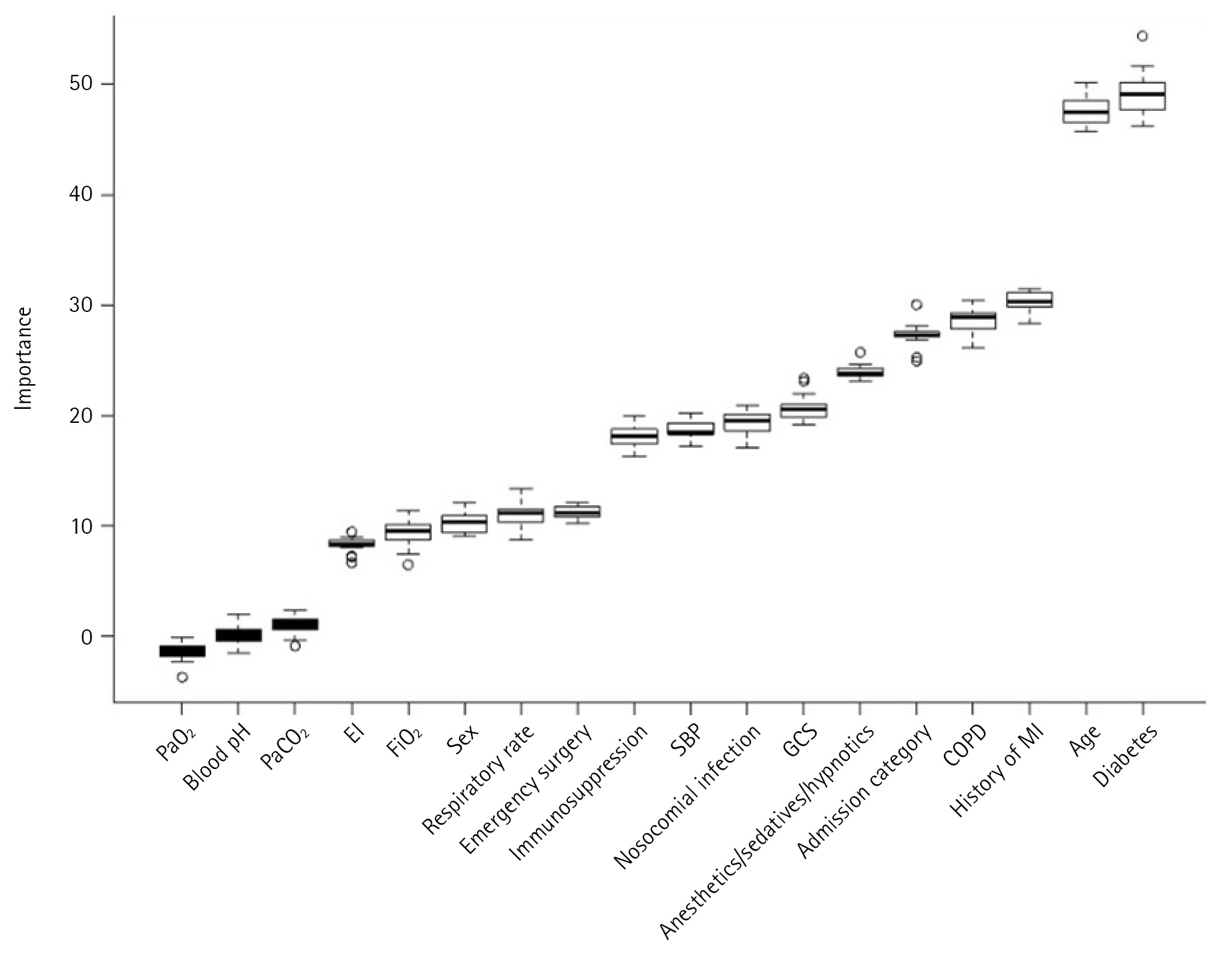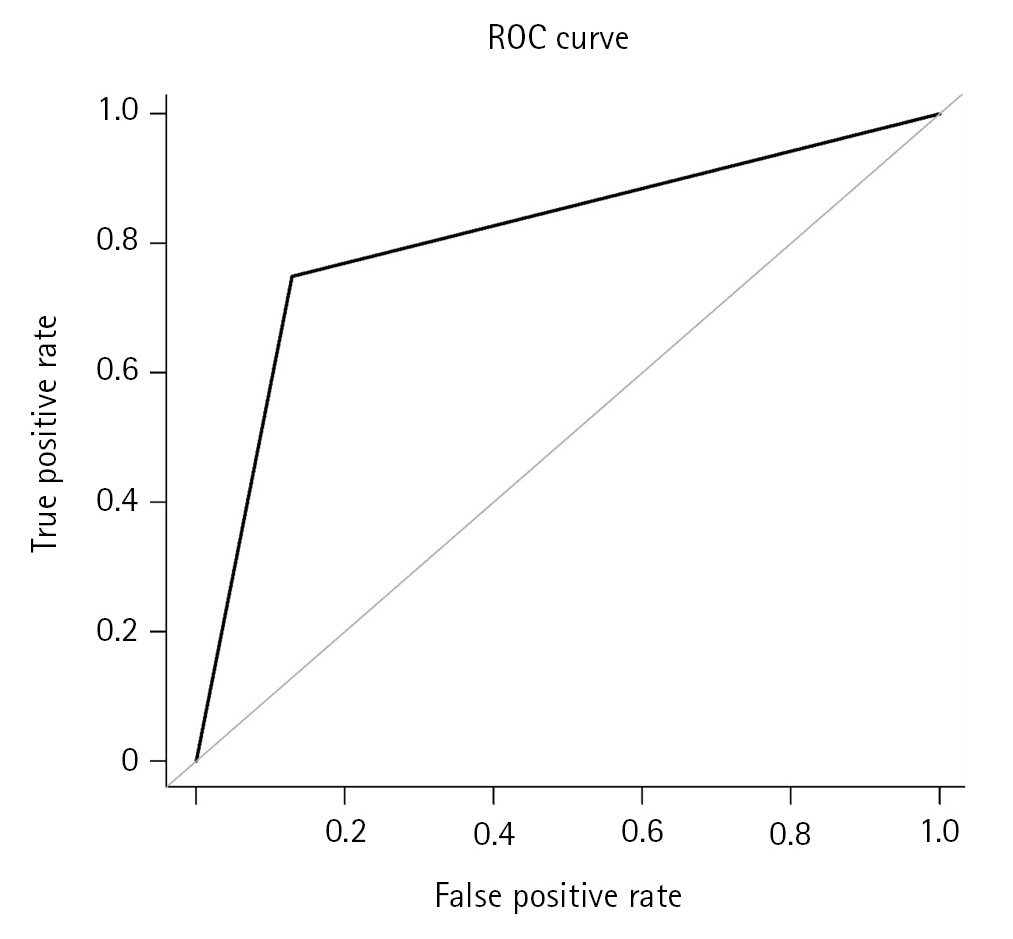Acute Crit Care.
2023 Feb;38(1):113-121. 10.4266/acc.2022.00927.
Association of Glasgow coma scale and endotracheal intubation in predicting mortality among patients admitted to the intensive care unit
- Affiliations
-
- 1Department of Health Management and Economics, Faculty of Medicine, AJA University of Medical Sciences, Tehran, Iran
- 2Critical Care Quality Improvement Research Center, Shahid Modarres Hospital, Shahid Beheshti University of Medical Sciences, Tehran, Iran
- 3Department of Anesthesiology, Faculty of Medicine, Shahid Beheshti University of Medical Sciences, Tehran, Iran
- 4Infectious Diseases and Tropical Medicine Research Center (IDTMRC), Department of Aerospace and Subaquatic Medicine, AJA University of Medical Sciences, Tehran, Iran
- 5AJA University of Medical Sciences, Tehran, Iran
- KMID: 2540321
- DOI: http://doi.org/10.4266/acc.2022.00927
Abstract
- Background
We assessed predictors of mortality in the intensive care unit (ICU) and investigated if Glasgow coma scale (GCS) is associated with mortality in patients undergoing endotracheal intubation (EI).
Methods
From February 2020, we performed a 1-year study on 2,055 adult patients admitted to the ICU of two teaching hospitals. The outcome was mortality during ICU stay and the predictors were patients’ demographic, clinical, and laboratory features.
Results
EI was associated with a decreased risk for mortality compared with similar patients (adjusted odds ratio [AOR], 0.32; P=0.030). This shows that EI had been performed correctly with proper indications. Increasing age (AOR, 1.04; P<0.001) or blood pressure (AOR, 1.01; P<0.001), respiratory problems (AOR, 3.24; P<0.001), nosocomial infection (AOR, 1.64; P=0.014), diabetes (AOR, 5.69; P<0.001), history of myocardial infarction (AOR, 2.52; P<0.001), chronic obstructive pulmonary disease (AOR, 3.93; P<0.001), immunosuppression (AOR, 3.15; P<0.001), and the use of anesthetics/sedatives/hypnotics for reasons other than EI (AOR, 4.60; P<0.001) were directly; and GCS (AOR, 0.84; P<0.001) was inversely related to mortality. In patients with trauma surgeries (AOR, 0.62; P=0.014) or other surgical categories (AOR, 0.61; P=0.024) undergoing EI, GCS had an inverse relation with mortality (accuracy=82.6%, area under the receiver operator characteristic curve=0.81).
Conclusions
A variety of features affected the risk for mortality in patients admitted to the ICU. Considering GCS score for EI had the potential of affecting prognosis in subgroups of patients such as those with trauma surgeries or other surgical categories.
Keyword
Figure
Reference
-
1. Hatchimonji JS, Dumas RP, Kaufman EJ, Scantling D, Stoecker JB, Holena DN. Questioning dogma: does a GCS of 8 require intubation? Eur J Trauma Emerg Surg. 2021; 47:2073–9.
Article2. Nakagawa K, Sagisaka R, Tanaka S, Takyu H, Tanaka H. Early endotracheal intubation improves neurological outcome following witnessed out-of-hospital cardiac arrest in Japan: a population-based observational study. Acute Med Surg. 2021; 8:e650.
Article3. Granfeldt A, Avis SR, Nicholson TC, Holmberg MJ, Moskowitz A, Coker A, et al. Advanced airway management during adult cardiac arrest: a systematic review. Resuscitation. 2019; 139:133–43.
Article4. Jeong S, Ahn KO, Shin SD. The role of prehospital advanced airway management on outcomes for out-of-hospital cardiac arrest patients: a meta-analysis. Am J Emerg Med. 2016; 34:2101–6.
Article5. Dunham CM, Barraco RD, Clark DE, Daley BJ, Davis FE 3rd, Gibbs MA, et al. Guidelines for emergency tracheal intubation immediately after traumatic injury. J Trauma. 2003; 55:162–79.
Article6. Mayglothling J, Duane TM, Gibbs M, McCunn M, Legome E, Eastman AL, et al. Emergency tracheal intubation immediately following traumatic injury: an Eastern Association for the Surgery of Trauma practice management guideline. J Trauma Acute Care Surg. 2012; 73(5 Suppl 4):S333–40.7. Sise MJ, Shackford SR, Sise CB, Sack DI, Paci GM, Yale RS, et al. Early intubation in the management of trauma patients: indications and outcomes in 1,000 consecutive patients. J Trauma. 2009; 66:32–40.
Article8. Duncan R, Thakore S. Decreased Glasgow Coma Scale score does not mandate endotracheal intubation in the emergency department. J Emerg Med. 2009; 37:451–5.
Article9. Jakob DA, Lewis M, Benjamin ER, Demetriades D. Isolated traumatic brain injury: routine intubation for Glasgow Coma Scale 7 or 8 may be harmful! J Trauma Acute Care Surg. 2021; 90:874–9.
Article10. Ribeiro SC. Decreased Glasgow Coma Scale score in medical patients as an indicator for intubation in the Emergency Department: why are we doing it? Clinics (Sao Paulo). 2021; 76:e2282.
Article11. Fallenius M, Skrifvars MB, Reinikainen M, Bendel S, Raj R. Common intensive care scoring systems do not outperform age and Glasgow Coma Scale score in predicting mid-term mortality in patients with spontaneous intracerebral hemorrhage treated in the intensive care unit. Scand J Trauma Resusc Emerg Med. 2017; 25:102.
Article12. Knox DB, Lanspa MJ, Pratt CM, Kuttler KG, Jones JP, Brown SM. Glasgow Coma Scale score dominates the association between admission Sequential Organ Failure Assessment score and 30-day mortality in a mixed intensive care unit population. J Crit Care. 2014; 29:780–5.
Article13. McNett M. A review of the predictive ability of Glasgow Coma Scale scores in head-injured patients. J Neurosci Nurs. 2007; 39:68–75.
Article14. Oh TK, Song IA, Jeon YT. Impact of Glasgow Coma Scale scores on unplanned intensive care unit readmissions among surgical patients. Ann Transl Med. 2019; 7:520.
Article15. Markazi-Moghaddam N, Fathi M, Ramezankhani A. Risk prediction models for intensive care unit readmission: a systematic review of methodology and applicability. Aust Crit Care. 2020; 33:367–74.
Article16. Homauni A, Zargar Balaye Jame S, Hazrati E, Markazi-Moghaddam N. Intensive care unit risk assessment: a systematic review. Iran J Public Health. 2020; 49:1422–31.
Article17. Sandri M, Zuccolotto P. Variable selection using random forests. In: Zani S, Cerioli A, Riani M, Vichi M, editors. Data analysis, classification and the forward search. Springer; 2006. p. 263-70.18. Jentzer JC, Murphree DH, Wiley B, Bennett C, Goldfarb M, Keegan MT, et al. Comparison of mortality risk prediction among patients ≥70 versus <70 years of age in a cardiac intensive care unit. Am J Cardiol. 2018; 122:1773–8.
Article19. Wang FD, Chen YY, Chen TL, Lin YT, Fung CP. Risk factors and mortality of nosocomial infections of methicillin-resistant Staphylococcus aureus in an intensive care unit. J Crit Care. 2011; 26:82–8.
Article20. Adigüzel N, Karakurt Z, Güngör G, Yazicioğlu Moçin O, Acartürk E, Soğukpinar O, et al. Mortality rates and risk factors associated with nosocomial Candida infection in a respiratory intensive care unit. Tuberk Toraks. 2010; 58:35–43.21. Skriver MV, Borch-Johnsen K, Lauritzen T, Sandbaek A. HbA1c as predictor of all-cause mortality in individuals at high risk of diabetes with normal glucose tolerance, identified by screening: a follow-up study of the Anglo-Danish-Dutch Study of Intensive Treatment in People with Screen-Detected Diabetes in Primary Care (ADDITION), Denmark. Diabetologia. 2010; 53:2328–33.
Article22. Saydain G, Awan A, Manickam P, Kleinow P, Badr S. Pulmonary hypertension an independent risk factor for death in intensive care unit: correlation of hemodynamic factors with mortality. Clin Med Insights Circ Respir Pulm Med. 2015; 9:27–33.
Article23. Cilli A, Erdem H, Karakurt Z, Turkan H, Yazicioglu-Mocin O, Adiguzel N, et al. Community-acquired pneumonia in patients with chronic obstructive pulmonary disease requiring admission to the intensive care unit: risk factors for mortality. J Crit Care. 2013; 28:975–9.
Article24. Chico-Fernández M, Abelardo Barea-Mendoza J, Servià-Goixart L, Ormazabal-Zabala T, Quintana-Díaz M, González-Robledo J, et al. Factors associated with death due to trauma in patients with a Glasgow Coma Scale score of 3 and bilateral fixed dilated pupils. Emergencias. 2021; 33:121–7.25. Bendinelli C, Ku D, King KL, Nebauer S, Balogh ZJ. Trauma patients with prehospital Glasgow Coma Scale less than nine: not a homogenous group. Eur J Trauma Emerg Surg. 2020; 46:873–8.
Article26. Sepahvand E, Jalali R, Mirzaei M, Ebrahimzadeh F, Ahmadi M, Amraii E. Glasgow Coma Scale versus Full Outline of UnResponsiveness Scale for prediction of outcomes in patients with traumatic brain injury in the intensive care unit. Turk Neurosurg. 2016; 26:720–4.27. Leitgeb J, Mauritz W, Brazinova A, Majdan M, Janciak I, Wilbacher I, et al. Glasgow Coma Scale score at intensive care unit discharge predicts the 1-year outcome of patients with severe traumatic brain injury. Eur J Trauma Emerg Surg. 2013; 39:285–92.
Article28. Mohammadi T, Mohammadi B. Drawing clinical pictures of heart failure with high mortality risk. Inform Med Unlocked. 2021; 26:100752.
Article
- Full Text Links
- Actions
-
Cited
- CITED
-
- Close
- Share
- Similar articles
-
- Superficial Keratopathy of Patients in Intensive Care Unit
- Evaluation of the Clinical Usefulness of Critical Patient Severity Classification System and Glasgow Coma Scale for Neurological Patients in Intensive Care Units
- The Prognostic Values of Acute Physiological Parameters in Hemorrhagic Stroke Patients: Differences Between Patients with High and Low Glasgow Coma Scale Scores on Admission
- Evaluating the Prognostic Efficacy of Scoring Systems in Neurocritical and Neurosurgical Care: An Insight into APACHE II, SOFA, and GCS
- Clinical Value of Glasgow Coma Scale: The First Ten Years




